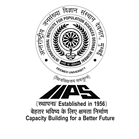- About IIPS
- Academics
- Study @ IIPS
- Departments
- Centres
- Controller of Examination
- Programme
- Distance and Online Education
- Training
- Facilities/Services
- Resources
- Virtual Learning
- Digital Initiatives (MHRD)
- Notice
- Seminars / Workshops / Conferences
- Conferences
- Publications
- Seminars
- Sponsored Research
- Workshops
- Collaboration
- National
- International
- NEP 2020
- Admission
- Courses
- Admission Bulletin
- TIME-TABLE For Admission 2025-26
- Model Question Papers
- Programme Coordinators
- Fellowships
- Academic Calendar
- International Students
- Visa Information
- Administration
- Faculty & Staff
- Research & Publications
- Library
- Information
- Right to Information
- Vigilance Officer
- Annual Report
- Director's Report
- Cells & Commitees
- Cells
- Commitees
- Committees of NEP 2020
- Staff Walfare Committee
- Cultural Committee
- Internal Committee
- Purchase Commitees
- Students Academic Committee
- Student Research Ethics Committee
- Anti-Ragging Committee
- Institutional Review Board
- Social Media Committee
- Prevention of Caste-based Discrimination Committee
- Code of Conduct and Professional Ethics
- National and International honours, Awards, Recognition, and Medals
- Online Facilities
- Employee's Corner
- Memorial Lectures
- Convocation
- IIPS Newsletters
- COVID 19 Information
- Life @ IIPS
Maternal Health Care in Uttar Pradesh from an intersectional lens: An evolving concern of quality
- Home
- Maternal Health Care in Uttar Pradesh from an intersectional lens: An evolving concern of quality
Abstract Content (not more than 300 word, should include: Introduction, Objective, Methodology, critical findings & Conclusion):
Despite the reduction in maternal mortality in India, concerns persist regarding the quality and equity of maternal healthcare services, particularly in Uttar Pradesh, which has the highest maternal mortality burden. While the coverage of maternal and newborn healthcare services has improved, socioeconomic and spatial inequalities remain significant. This study examines the adequacy of quality maternal health care in Uttar Pradesh using an intersectional approach, focusing on how social, economic, and educational factors shape healthcare access and utilisation.
Using data from the 2015-16 and 2019-21 rounds of the National Family Health Survey (NFHS-DHS), this study evaluates changes in the adequacy of antenatal care (ANC), intrapartum care (IPC), and postnatal care (PNC). It also identifies vulnerable PSUs (villages and Census Enumeration Blocks) where disadvantaged groups experience barriers to healthcare. Findings show notable improvements in maternal health care, with the highest gains in PNC timeliness and IPC quality. However, women’s counselling during ANC remains critically low.
Analysis of PSU characteristics reveals persistent disparities. SC/ST women in PSUs dominated by the general caste had the lowest improvement in ANC and IPC, while their PNC improvements were lowest in OBC-dominated PSUs. Economic status also plays a role—while non-poor-dominated PSUs showed better overall maternal healthcare coverage, improvements among disadvantaged groups were lower than expected. Surprisingly, SC/ST women in PSUs dominated by educated populations experienced lower improvements in maternal health services compared to those in less-educated PSUs, suggesting potential gaps in policy targeting.
These findings underscore the need for targeted policy interventions beyond pro-poor approaches to ensure equitable and quality maternal healthcare across all social and economic groups.
Abstract theme:
In case of not been selected for oral presentation, do you want to be considered for the poster presentation ?:
Yes
Do you require financial support to attend the seminar ? (Not applicable for virtual meet):
No.
Gender:
Male
Evaluation Status:
No
